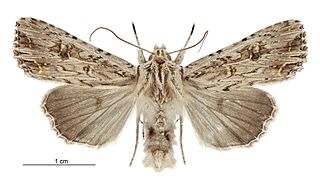
Ichneutica lignana is a moth of the family Noctuidae. It is endemic to New Zealand. This species is found on the Three Kings Islands as well as the North, South and Stewart Islands. This species lives in a variety of habitats including coastal areas, tussock grasslands, shrublands, and native forest, at a range of altitudes from sea level to over 1300 m. I. lignana is quite distinctive in appearance with its dark markings on the abdomen and forewings although it is possible to confuse Ichneutica morosa, Meterana pansicolor and Meterana pascoi with this species. Adults are on the wing throughout the year in the northern parts of the New Zealand but are restricted to the months of October to April in the more southern parts of the country.

Ichneutica maya is a moth of the family Noctuidae. It is endemic to New Zealand. It is found in the mountains in southern half of the North Island and in the South Island. I. maya is a distinctively coloured and patterned moth and as such is unlikely to be confused with similar species. I. maya can be found in the southern half of the North Island down through the South Island. This species can be found in alpine to subalpine zones with high rainfall but in Southland this species can be found down to sea level. This life history in the wild is unknown, nor has its larval host species been confirmed. Adults are on the wing from December to March and are attracted to sugar and light traps.

Ichneutica morosa is a moth of the family Noctuidae. It is endemic to New Zealand and is found in the southern parts of the North Island and throughout the South Island. I. morosa is common in the eastern parts of both those islands and also in Fiordland. I. morosa can be found from altitudes ranging from lowlands to the alpine zone. I. morosa is absent from the range of its closely related species I. mustulenta, that is from the northern North Island. The larvae of I. morosa are known to feed on Poa astonii and also on other Poa species including introduced species. As well as its standard form the adult moths have a grey colour morph with the head and thorax being a grey and mottled brown, and the forewing being a pale greyish ochreous to a deep brown, suffused with grey. I. morosa can be confused with I. mustulenta and I. lignana. Adults are on the wing from November to April.

Ichneutica nullifera is a moth of the family Noctuidae. This species is endemic to New Zealand and can be found in the Tongariro National Park, along the Wellington coast and throughout the South Island. The adults are large and the forewing of adults can vary in colour from pale fawn to dark grey. The larvae are coloured a bright yellow-brown with a paler underside. The larval host species are in the genus Aciphylla and as a result the adult moths are often found in habitat dominated by species in this genus. Adults are on the wing from November to early April and are sometimes attracted to light.
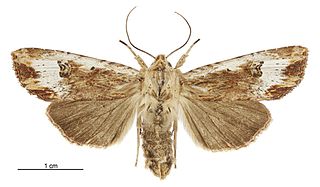
Ichneutica rubescens is a moth of the family Noctuidae. It is endemic to New Zealand. This species can be found locally in the North Island but is widespread throughout the South Island and is present on both Stewart Island and the Auckland Islands. I. rubescens has a round or oval mark near the centre of the forewing that encloses a dot. This is diagnostic of this species. I. rubescens inhabits tussock grasslands, beech as well as podocarp forests. Larval hosts are likely herbaceous plants such as grasses and herbs and larvae have been reared on Gunnera prorepens. Adults of this species are on the wing from December to April and are attracted to light.
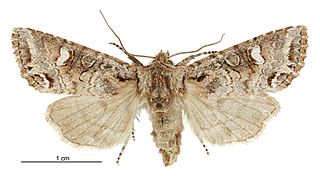
Ichneutica sericata is a moth of the family Noctuidae. It is endemic to New Zealand. This species is variable and difficult to distinguish from I. skelloni specimens. It is known from the southern part of the South Island and from Stewart Island. There has been one specimen collected in Taranaki but although Robert Hoare determined the species, he expressed reservations given the location of collection. I. sercata inhabits shrubland at altitudes of between 470 and 900m. The life history of this species is unknown as are the host species of its larvae. The adults of this species are on the wing in August at Stewart Island and in November and December in the South Island.

Ichneutica atristriga is a moth of the family Noctuidae. It is endemic to New Zealand and is found through out the North, South and Stewart Islands. The larval hosts likely include tussock grasses included Poa cita, P. colensoi and Festuca novae-zelandiae. Larvae have been reared on species in the genera Bromus and Festuca. The adults of this species are on the wing from November to May. I. atristriga can possibly be confused with the smaller species I. propria. However I. atristriga has thorax and forewings that have a pinkish tinge and I. propria has a dark streak on the discal part of the forewing which I. atristriga lacks. A study has indicated that the population numbers of this species have decreased.
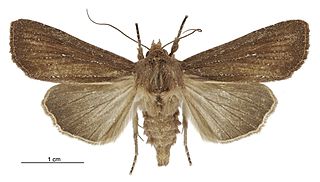
Ichneutica micrastra is a moth of the family Noctuidae. It is endemic to New Zealand. This species has been found only in the North Island and has been collected in the Northland, Auckland, Whanganui and Wellington regions. The preferred habitat of this species is wetlands and heathlands including gum fields in Northland. Adults of this species are on the wing from October to December. The life history of this species is unknown as are the host species of its larvae however it has been hypothesised that the likely larval host is a grass or grass like plant. This species is very similar in appearance to I. phaula and I. sapiens but can be distinguished as a result of differences in male antennae, the shape, colour and size of forewings, the range of the species as well as differences in genital shape.

Ichneutica paraxysta is a moth of the family Noctuidae. It is endemic to New Zealand. This species is very similar in appearance to its close relative I. acontistis but as the range of the two species do not overlap this is unlikely to cause confusion. I. paraxysta is only found in the North Island at the subalpine zones in the Mount Taranaki region and at Mount Ruapehu. It prefers tussock grassland and shrubland habitat. The life history of this species is unknown as are the host species of its larvae however it has been hypothesised that the larval host plants are species in the genera of Poa and Festuca.
Ichneutica subcyprea is a moth of the family Noctuidae. This species is endemic to New Zealand. This species is very similar in appearance to I. chlorodonta. It feeds on fern species in the genus Tmesipteris. It is the only New Zealand noctuid known to exclusively feed on ferns. The preferred habitat of this species is humid native forest and the adults are on the wing from September to December.
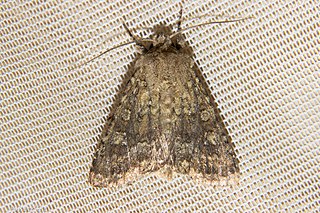
Ichneutica barbara is a moth of the family Noctuidae. This species is endemic to New Zealand and is only found in the South Island, more commonly on the eastern side of the South Island. This species has a grey forewing and is visually very similar in appearance to its close relative I. omicron. However the adult male of I. barbara has a yellow anal tuft in comparison to the grey tuft of I. omicron. In collections I. barbara has sometimes been confused with I. sistens. I. barbara appears to inhabit shrubland localities. The life history of this species is unknown as are the host species of the larvae but adults are on the wing from October to December.

Ichneutica virescens is a moth of the family Noctuidae. It is endemic to New Zealand, and is found in the southern North Island and throughout the South Island. The species is found in alpine, sub-alpine, and down to sea-level in grassland habitats. Adults are on the wing from November through to April. The likely larval host may be grasses, but larvae have been reared on a range of plants. The adults are similar to I. panda, I. falsidica and I. nobilia, but is distinguished by size, wing colouration, and antennae formation.
Ichneutica sapiens is a moth of the family Noctuidae. This species is endemic to New Zealand. I. sapiens is found in the central North Island, in the South Island in Westland and also the southern parts of the South Island, and in Stewart Island. This species inhabits wetland habitat but its life history is unknown as are the host species of its larvae. The adult moths are on the wing between December and early January and are attracted to sugar traps and to light. I. sapiens is very similar in appearance to I. micrastra but is a smaller moth with a shorter wingspan, has differently formed antennae and slightly different forewing markings.
Ichneutica emmersonorum is a moth of the family Noctuidae. This species is endemic to New Zealand. It is very similar to I. similis but its forewings have visual differences. I. emmersonorum is only known from the North Island volcanic plateau. The life history of this species is unknown as are the host species of its larvae however Robert Hoare argues that the likely larval host plant species is a grass or grass like plant. The adult moths are on the wing from November to January. This species is attracted to sugar traps and to light.
Ichneutica theobroma is a moth of the family Noctuidae. This species is endemic to New Zealand. The males of this species has a pink chocolate brown appearance to its forewings with a small white dot. The males of this species can be distinguished from the 'northern dark form' of Ichneutica arotis as they have broader shaped forewings with less markings than the latter species. The females are extremely difficult if not impossible to tell apart. I. theobroma are found in the northern parts of the North Island and inhabit kauri forests. The life history of this species is unknown as are the host species of its larvae although it has been hypothesised that larval hosts include Gahnia setifolia and Gahnia xanthocarpa. Adults of this species are on the wing from mid September until early November and are attracted to light.
Ichneutica lyfordi is a moth of the family Noctuidae. This species was named in honour of its first collector, Brian M. Lyford, and is endemic to New Zealand. It is only known from the Von Valley in the Otago Lakes area of the South Island. As at 2021, only the male of the species has been collected. The life history of this species is unknown as are the host species of its larvae. Adults are on the wing in February and are attracted to light.
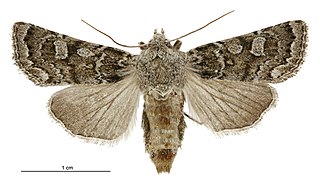
Ichneutica sistens is a moth of the family Noctuidae. This species is endemic to New Zealand. It can be found in the central North Island and throughout the South Island, although it is more common on the eastern side of that latter Island. It is very variable in both colour and size. I. sistens prefers open habitat such as tussock grasslands, dunes and braided rivers. Larval host species include grasses in the family Poaceae and include species in the genera Rytidosperma and Elymus, as well as Poa cita and Agrostis capillaris. Adults are on the wing from January to May and are attracted to light.
Ichneutica haedifrontella is a moth of the family Noctuidae. This species is endemic to New Zealand. It is only known from scattered areas in the North and South Islands. In the North Island it has only been collected in the Pouakai Range in Taranaki. In the South Island it is known from the Nelson, Buller, North Canterbury, Otago Lakes and Fiordland regions. It inhabits alpine to subalpine zones. The life history of this species is unknown as are the host species of its larvae in the wild. Larvae have been reared on species in the Chionochloa genus. Adults are on the wing from December to February and are attracted to light. This species has a smaller dwarf form that can be found in the Pouakai Range and at Dart Hut.
Ichneutica inscripta is a moth of the family Noctuidae. This species is endemic to New Zealand. This species is found from south Auckland to Taranaki in the North Island. It prefers to inhabit dense native forest with high rainfall at higher altitudes. The life history of this species is unconfirmed as are the host species of its larvae but is likely to be similar to its close relative I. infensa. This species is very similar in appearance to its close relative I. infensa but has more strongly patterned forewings. The adults of this species are on the wing from late October to January.
Ichneutica supersulcana is a moth of the family Noctuidae. This species is endemic to New Zealand and is only known from the Tararua Ranges and at Tongariro National Park. This species has been collected in subalpine tussock grasslands as well as subalpine shrubland and at the margins of Fuscospora cliffortioides forest. The life history of this species is unknown as are the host species of its larvae. The adults of this species are on the wing in February and are attracted to light. It appears to be restricted to higher altitudes in comparison to its close relative I. sulcana.I. sulcana and I. supersulcana are very similar in appearance with no reliable visible differences between the two having been discovered. However, there are distinct differences in the male abdomen and genitalia of these two species.












